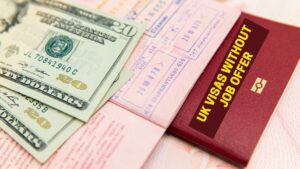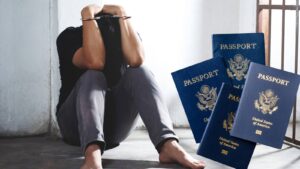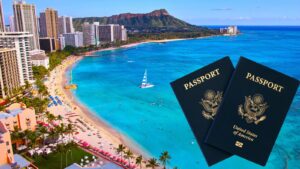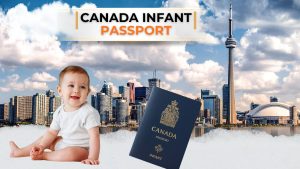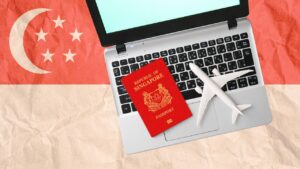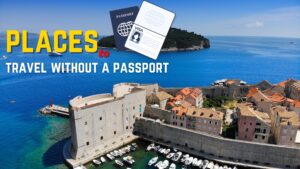Applying for a U.S. visa is one of the most essential steps for international travelers, students, and professionals. At the center of this process is the American visa form DS 160, a comprehensive online document required by the U.S. Department of State for all non-immigrant visa categories. Traveling for business, tourism, education, or employment, completing the DS-160 form accurately is a mandatory prerequisite before scheduling your visa interview.
Here, know every aspect of the DS-160 form — from what it is, how to fill it, visa-specific requirements, processing time, and common mistakes to avoid. This is the most vital step toward your U.S. travel dream, so let’s get into the details.
What is the DS-160 Form?
The DS-160 form is an Online Nonimmigrant Visa Application that collects all the required personal, travel, employment, and security information needed for processing a U.S. non-immigrant visa. This digital form is submitted through the Consular Electronic Application Center (CEAC) and is reviewed by the U.S. consular officers at the time of your interview.
It replaces older paper-based forms and integrates several data checkpoints to reduce fraudulent applications. Once submitted, the American visa form DS 160 generates a unique confirmation barcode which is essential for booking the visa interview. Without this barcode page, the U.S. Embassy or Consulate will not process your visa application.
Hence, the DS-160 form acts as your initial statement of intent, which means consular officers use it to determine the validity of your visit, the accuracy of your documents, and your eligibility to enter the U.S. It is the digital foundation of your entire visa application process.
How to Fill DS-160 Form: Step-by-Step Instructions
Filling the DS-160 form online application is not just a formality—it’s your first impression. A mistake here could cause visa delays or denials. Follow these steps in detail:
Step 1: Access the Form on the CEAC Website
Start by visiting the official Consular Electronic Application Center at https://ceac.state.gov. Choose your location (the city where your visa interview will take place), then begin a new DS-160 form.
It’s essential to save your Application ID, which appears in the top right corner. You will also choose and answer a security question so that you can retrieve your form later if needed. This is helpful in case the session times out or you need to revisit your form another day.
Step 2: Enter Personal Information
You’ll be asked to enter your full name (as in your passport), gender, nationality, birth details, marital status, national identification number, and passport number. Ensure that your name matches exactly with your passport to avoid rejection.
If you have a U.S. Social Security Number or Taxpayer Identification Number, enter it here. Any discrepancies in these fields could result in issues during visa processing.
Step 3: Fill in Travel Information
Select the purpose of your travel such as business, tourism, study, or work. You must also mention your intended travel dates, duration of stay, U.S. address (like hotel, university, or employer), and who is paying for your trip.
Be as accurate as possible, especially when filling in your U.S. point of contact. This could be your university’s international student office, a U.S.-based relative, or your employer’s HR department.
Step 4: Provide Travel Companion Information
Indicate whether you are traveling alone or with someone. If you’re traveling with family, you’ll need to provide details about each member. Consular officers often use this data to confirm family ties and travel intentions.
Step 5: List Previous U.S. Travel History
If previously traveled to the U.S., you must mention the dates and visa types. Disclose any prior visa refusals, overstays, or deportations truthfully, as this information is cross-verified against U.S. immigration records.
Failure to disclose past visa issues—even minor ones—can be considered misrepresentation and may result in a visa ban.
Step 6: U.S. Point of Contact
You must list a point of contact in the U.S., which can be a family member, friend, employer, school, or institution. Include their full name, address, phone number, and email. This information must be valid, as the consular officer may use it to verify your purpose of visit.
Step 7: Family Details
You must provide details about your father and mother, including their names, dates of birth, and whether they are in the U.S. If your spouse or children are traveling with you, they must be listed as well.
This section helps validate your family background and strengthens your home-country ties, especially for visitor and student visa applications.
Step 8: Educational and Employment History
Be ready to list your complete academic history, current and past employers, job roles, contact details, and duration of employment. If you are self-employed or a student, indicate so and include relevant information.
For professionals, the visa officer may cross-reference your employment details with company databases or ask for proof like offer letters and salary slips.
Step 9: Security and Background Questions
These are critical and include topics such as:
- Health conditions
- Criminal record
- Drug use
- Security violations
- Immigration fraud
- Terrorist activities
Answering falsely here can permanently bar you from entering the U.S. Answer “Yes” only if absolutely applicable and be prepared to provide supporting documentation during the interview.
Step 10: Upload a Compliant Photo
Your digital photo must meet specific U.S. visa photo requirements:
- Size: 2×2 inches (51×51 mm)
- White background
- No glasses
- Neutral expression
- Taken within the last 6 months
Upload a valid image online, and also carry a physical copy to the interview.
Step 11: Review and Submit
Before submitting, review all answers carefully. Once submitted, you cannot make changes. After submission, print the confirmation page with the barcode and bring it to your interview. Save a PDF version for your records.
American Visa Form DS-160: How to Fill Online for B1/B2, H1B, and F1 Visas
DS-160 Form for B1/B2 Visa (Tourist/Business)
If you are applying for a B1/B2 visa, it is essential to clearly indicate the nature of your travel—whether it is business-related (B1), tourism or medical treatment (B2), or a combination of both (B1/B2). The DS-160 form will specifically ask you to choose one of these categories, and your choice should reflect your actual travel purpose to avoid confusion during the visa interview process. This classification helps U.S. consular officers better assess your eligibility for entry under the appropriate visa type.
In the Travel Information section of the DS-160, you will need to provide specific details about your trip, such as:
- The exact purpose of the visit (e.g., attending a conference, business meetings, tourism, or medical treatment).
- Who is financing the trip (self-funded, sponsored by a company or relative).
- The intended dates of arrival and departure.
- A tentative travel itinerary including cities or states you plan to visit.
You should also prepare and have ready the following documents to support your application and interview:
- Invitation letters from business contacts or family members.
- Hotel bookings or accommodation details.
- Flight reservation or travel tickets.
- Evidence of past travel history, such as prior U.S. visas or passport stamps.
Additional points to consider:
- You may be asked about contacts in the U.S., such as relatives, friends, or business associates.
- Be prepared to explain how the trip fits into your personal or professional life and demonstrate your intent to return to your home country after your visit.
B2 Visa: How to Apply, Requirements & Fees Explained
DS-160 Form for H1B Visa (Work Visa)
For H1B visa applicants, filling out the DS-160 form requires thorough attention to the employment-related sections. You will need to provide detailed and accurate information, including:
- U.S. employer’s contact information (company name, address, phone number).
- Your job title and detailed description of job duties that match the specialty occupation you are hired for.
- Salary details as stated in the Labor Condition Application (LCA).
- Location(s) of employment, especially if you will work at multiple sites or client locations.
- Duration of employment or contract, including start and end dates.
Important documents to have on hand:
- Form I-797 (Notice of Action) which confirms your petition approval.
- Labor Condition Application (LCA) approval.
- Employment offer letter or contract from your U.S. employer.
- Any other supporting documents submitted by your employer during the H1B petition process.
Additional considerations:
- Ensure all employment information matches the petition filed with USCIS; inconsistencies can cause processing delays or denial.
- Any changes in job location, duties, or employer must be accurately reflected in the DS-160 and supported by relevant approvals.
H-1B Visa 2025 – Everything You Need to Know Before Applying
DS-160 Form for F1 Student Visa (Academic Study)
For F1 visa applicants, the DS-160 form demands careful completion to ensure alignment with your educational institution’s records. You must include:
SEVIS ID number (found on the top right of your I-20 form).
Name and address of your U.S. school or university, and the Designated School Official’s (DSO) contact details.
- Details of your academic program, including:
- Your course or major.
- The level of study (Bachelor’s, Master’s, PhD, etc.).
- Program start and end dates matching your I-20.
- Proof of financial support, clearly stating:
- The source of funding (personal, family, scholarship, or sponsor).
- Evidence such as bank statements, affidavits of support, or scholarship letters demonstrating sufficient funds to cover tuition and living expenses.
- Complete and accurate educational history including previous schools attended, degrees earned, and dates of attendance.
Important tips:
- Make sure the information you provide exactly matches the details on your Form I-20 and supporting financial documents.
- Discrepancies can cause additional scrutiny or even refusal during your visa interview.
- Be prepared to discuss your academic goals and plans to return home after your studies, which is an important factor in visa approval.
F1 Visa: Requirements, Renewal, Processing Time!
DS-160 Form Processing Time
The processing time for the DS-160 form submission itself is immediate, meaning that once you complete and submit the form online, the information is instantly recorded in the U.S. Department of State’s system. The DS-160 is just one part of the overall visa application process, which can take several weeks or even longer depending on several factors, including:
- U.S. Embassy or Consulate appointment availability: Each embassy or consulate has varying wait times for scheduling visa interviews, which fluctuate based on location, season, and demand. During peak travel seasons or at high-volume consulates, the wait can extend from a few days to several weeks.
- Administrative processing: In some cases, your application may undergo additional security or background checks known as administrative processing. This step can add weeks or months to your timeline, especially if extra documentation or verifications are required.
- Visa type and travel urgency: Certain visa categories, such as student visas (F1) or work visas (H1B), may have different processing times depending on the complexity of the case or prevailing immigration policies. Emergency or urgent travel requests might qualify for expedited appointments but are granted on a case-by-case basis.
It’s important to note that the DS-160 form itself is not “processed” separately; rather, the information you provide is reviewed by the consular officer during your visa interview. Therefore, accuracy and completeness in your DS-160 are critical to avoid delays or complications in your overall visa approval.
DS-160 Form Common Mistakes to Avoid
Filling out the DS-160 form requires careful attention to detail, as errors or omissions can result in visa delays, requests for additional information, or outright denials. Below are some common mistakes and why you should avoid them:
1. Inconsistent Information:
Ensure all information you provide in the DS-160 form perfectly matches other supporting visa documents such as your Form I-20 (for F1 visas), Form I-129 petition (for H1B visas), your passport details, and any previous visa documents. Mismatched names, dates, or addresses can raise red flags during the interview and cause processing delays.
2. Typos in Names or Dates:
Spelling mistakes or errors in important dates (birthdate, travel dates, passport expiration) may seem minor but can lead to confusion or suspicion. For example, even a small typo in your name that differs from your passport can invalidate your application. Always double-check every entry, especially critical fields like your name, date of birth, and passport number.
3. Incorrect Photo Upload:
The DS-160 requires you to upload a digital photo that strictly adheres to U.S. visa photo specifications (e.g., size, background color, head position). A photo that is blurry, too dark, too bright, or does not meet the required dimensions will be rejected, causing delays or the need to resubmit your application. Review the photo guidelines carefully before uploading.
4. Wrong Visa Type Selected:
Choosing the incorrect visa category can have serious consequences. For example, applying for a B2 tourist visa when your purpose is to work will almost certainly lead to denial. Ensure you understand the visa type that corresponds to your travel purpose and select it correctly on the form.
5. Incomplete Work/Education History:
Leaving gaps or failing to provide complete details about your previous employment, education, or training can cause suspicion about your intentions or background. Be honest and thorough, listing all relevant experiences and explaining any gaps if necessary.
6. Omitting Past Visa Rejections or Overstays:
It is mandatory to disclose any previous visa refusals, cancellations, or overstays in the U.S., even if they occurred years ago. Failing to mention this information can be viewed as misrepresentation and lead to permanent ineligibility or visa denial. Transparency is always the best policy.
Preparing for your visa interview, remember that what you write in the DS-160 form online application will be reviewed by the consular officer. Make it count by ensuring everything is correct, supported by documents, and in line with your travel purpose.
FAQs
1. What is the American visa form DS 160?
The DS-160 is an online non-immigrant visa application form used by the U.S. Department of State to collect information from applicants seeking temporary travel to the United States. It is mandatory for most visa categories, including B1/B2, H1B, and F1 visas.
2. Where can I fill out the DS-160 form online?
You can complete the DS-160 form on the official Consular Electronic Application Center (CEAC) website at https://ceac.state.gov/. Make sure to use the official site to avoid scams.
3. Do I need to complete the DS-160 form before scheduling my visa interview?
Yes, submitting the DS-160 form online and printing the confirmation page with the barcode is a mandatory step before you can book your visa interview appointment at a U.S. Embassy or Consulate.
4. Can I save my progress and complete the DS-160 form later?
Yes, the DS-160 form allows you to save your application and return later using your Application ID and security question. It is important to save frequently to avoid losing data due to session timeouts.
5. How long does it take to fill the DS-160 form?
Typically, filling the DS-160 form takes between 60 to 90 minutes, depending on your visa category and the amount of information you need to provide. Preparing documents beforehand can speed up the process.
6. Can I edit my DS-160 form after submitting it?
No, once submitted, the DS-160 form cannot be edited. If you find a mistake after submission, you must fill out and submit a new DS-160 form and bring the new confirmation page to your visa interview.
7. What documents do I need to fill out the DS-160 form?
You will need your valid passport, travel itinerary (if available), dates of your last five visits or trips to the U.S. (if any), resume or CV, details of your employer or school, and a digital photograph that meets U.S. visa photo requirements.
8. Is the DS-160 form the same for all U.S. non-immigrant visas?
Yes, the DS-160 is used for most non-immigrant visas, but the questions may vary slightly based on the visa category you select at the beginning. For immigrant visas, a different form called the DS-260 is used.
9. What should I do if I get an error while submitting the DS-160 form online?
Common errors include incorrect or incomplete fields, photo upload issues, or session timeouts. Review all data carefully, ensure your photo meets specifications, and try again. If problems persist, contact the support center or your local U.S. Embassy for help.
10. What are common mistakes to avoid when filling out the DS-160 form?
Avoid typos, inconsistencies with your supporting documents, uploading incorrect photo formats, omitting past visa refusals or overstays, and rushing through the form. Double-check all entries, as any discrepancies can delay your visa processing or cause denial.

